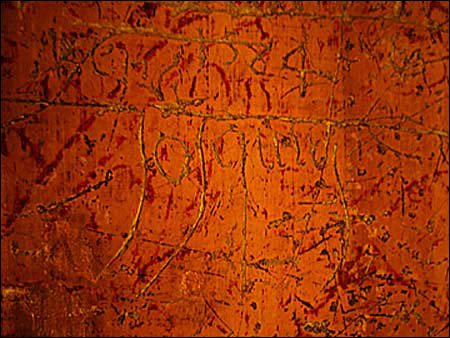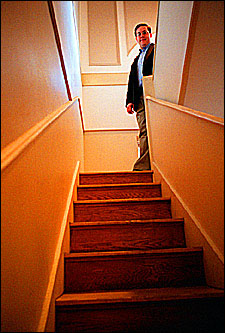The Cantoria Code
Grad student explores newly found Sistine Chapel graffiti

The choir loft, or cantoria, in the Sistine Chapel is a smallish, 8-foot-by-12-foot nook carved into the stone of the chapel wall and dimly illuminated through its original colored glass window. For the first three and a half centuries of the chapel’s history (it was built in the 1470s), only singers were allowed to enter the cantoria. One of the things they did in there, aside from music, has only recently come to light: Signatures, hundreds of them, were uncovered during the Vatican’s restoration – among them, the only extant signature of the turn-of-the-16th-century composer Josquin. Carved and scratched over several centuries of singing, the signatures now stand as a who’s who of the papal choir.
Graduate student Evan MacCarthy used part of his 2004 Morrill Fellowship to visit the Vatican this past summer to explore the cantoria and examine the signatures with his own eyes.
“In 1800 the original cantoria frescoes – gold drapes with the papal seal – were whitewashed and covered,” he explains. “But we have evidence from the mid-18th century that refers to carvings in the wall, particularly the name of Josquin. Scholars knew something was there.
“Restorations of the frescoes of the entire chapel, particularly the frescoes by Michelangelo, began in 1980. They started with the ceiling, then did ‘The Last Judgement,’ and then the frescoes on the side walls. What was dark and ashy now explodes with color and light. In 1997, they finally came to uncovering the cantoria. The reason everyone is excited is we didn’t have anything in his [Josquin’s] hand. Of course we don’t really know if it’s him but… ,” MacCarthy said with a smile.
The German musicologist Klaus Pietschmann first wrote (1999) about the signatures, paying close attention to the “signature” of Josquin and its potential authenticity; two years later, Oxford University Press put out a collection of essays edited by Richard Sherr with a color image of the cantoria graffito on the cover. The cover photograph fascinated MacCarthy.
“I looked at this and thought, ‘There are hundreds of other names. I wonder who else is there.’”
MacCarthy called the man who’d led his high school tour of the Vatican museums nine years ago, Walter Persagati, who remembered him. Persagati, now retired as a director of operations for the Vatican Museums, met MacCarthy at the exit.
“It was 7:30 in the morning, before the museums opened. At the entrance, thousands of people were already in line. We walked in, waving to guards. We ran straight through the museum, flying by the art, to the chapel, though several sets of secret doors. The stuffy hallways were still hot from the previous night and the guards were flinging open shutters. We hurried down a few stairs into a very narrow, cold passageway that opened out into the Sistine Chapel. There, it was absolutely silent. Dr. Persagati turned to me, very unassuming: ‘Sometimes I just come here by myself and I’m still overwhelmed.’”
MacCarthy was locked into the cantoria for three hours, overlooking an empty Sistine Chapel (save one guard in the corner), where he examined and photographed the signatures he found covered in dust and dirt.
“My hands were shaking so much the first photos were blurry. There were carvings all over the place, a mess of markings that were messages, lines of music, lyrics, notes, dates, even what appeared to be an anarchy symbol. There were Latin and German names from 1570 or 1625, then, from the 1700s, several English names. Even in the stairwell there were hundreds of names; sometimes people identifying themselves by voice part.”

He didn’t get them all; he couldn’t. There were too many.
“The museum officially opened at 8:45 and by 9:15 the place was a zoo. It was wall-to-wall bodies – loud, deafening. I couldn’t think straight.”
When MacCarthy left the Sistine Chapel he had a plan. He’d come back with a better list of who was known to have been singing in the chapel. He’d need a better camera and tripod, more light, and would need to go through a much more difficult Vatican permission process to be able to spend the necessary few days working there. But he also came away with even more questions.
“A lot of these people we know because there are lists and diaries documenting the singers’ names starting in the 16th century. The thing that hasn’t been documented is the music: There are two music excerpts carved in the wall; why did they choose these? How many of the singers were composers? Instead of a name, did they sign a tune? How and why would they carve their names in the wall? Can you see from where signatures are located in the loft what voice part a singer was? There is still much to do!”
MacCarthy, now in his second year of graduate study in the Music Department, where he studies 15th and 16th century motets and chansons, is hoping to return to the cantoria in the summer of 2006 with a better camera, better tripod, better light, and more time.




